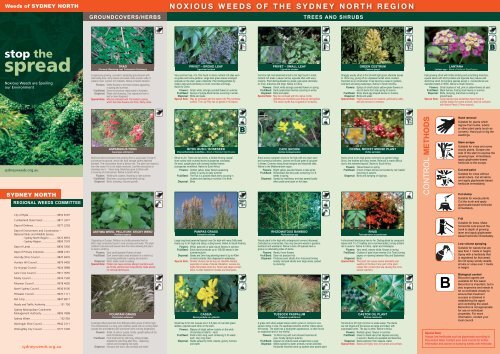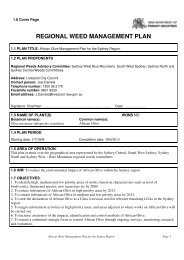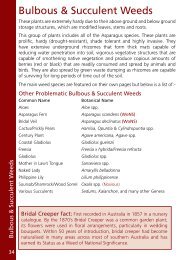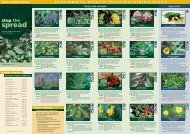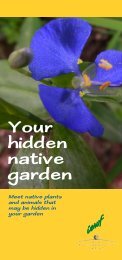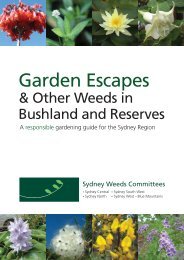North - Sydney Weeds Committees
North - Sydney Weeds Committees
North - Sydney Weeds Committees
You also want an ePaper? Increase the reach of your titles
YUMPU automatically turns print PDFs into web optimized ePapers that Google loves.
<strong>Weeds</strong> of SYDNEY NORTH<br />
groundcovers/herbs<br />
N o x i o u s W e e d s o f t h e s y d n e y n o r t h r e g i o n<br />
trees and shrubs<br />
stop the<br />
spread<br />
TRAD<br />
(Formerly Wandering Jew) Tradescantia fluminensis<br />
Privet – broad leaf<br />
Ligustrum lucidum<br />
Privet – small leaf<br />
Ligustrum sinense<br />
green cestrum<br />
Cestrum parqui<br />
Lantana<br />
Lantana spp – Weed of National Significance<br />
Noxious <strong>Weeds</strong> are Spoiling<br />
our Environment<br />
A vigorously growing, succulent, spreading groundcover with<br />
alternating dark, shiny leaves and weak roots at each node. It<br />
prefers moist, nutrient rich habitats. Native to South America.<br />
Flowers: White flowers in terminal clusters appearing<br />
in spring and summer.<br />
Fruit/Seed: Does not produce viable seed in Australia.<br />
Dispersal: Water and dumping. Can reproduce from a<br />
leaf or stem fragment.<br />
Special Note: May be confused with Commelina cyanea,<br />
which has blue flowers and thick, fleshy roots.<br />
Very common tree, 4 to 10m found in moist, nutrient rich sites such<br />
as gullies and home gardens. Large dark green leaves arranged<br />
opposite on the stem, paler underside. Plant distinguishable by<br />
raised, pale spots (lenticels) on trunk, branches and twigs.<br />
Native to China.<br />
Flowers: Small, white, strongly scented flowers in summer.<br />
Fruit/Seed: Sprays of purple-black berries occurring in winter.<br />
Dispersal: Birds and water.<br />
Special Note: May be confused with the native Lilly Pilly (Acmena<br />
smithii). The Lilly Pilly has oil glands in its leaves.<br />
Common tall multi-stemmed shrub to 3m high found in moist,<br />
nutrient rich areas. Leaves narrow, opposite often with wavy<br />
margins. Plant distinguishable by raised, pale spots (lenticels)<br />
on trunk, branches and twigs. Native to China.<br />
Flowers: Small, white strongly scented flowers in spring.<br />
Fruit/Seed: Dark purple-black berries occurring in winter.<br />
Dispersal: Birds and water.<br />
Special Note: May be confused with the native myrtle<br />
(Backhousia myrtifolia) and Breynia oblongifolia.<br />
The native myrtle has oil glands in its leaves.<br />
Straggly woody shrub 2-3m tall with light green alternate leaves<br />
to 12cm long, giving off an unpleasant smell when crushed.<br />
Imported as an ornamental, it has become a weed in gardens,<br />
bushland and along waterways. Native to South America.<br />
Flowers: Sprays of small tubular yellow-green flowers on<br />
end of stems from late spring to autumn.<br />
Fruit/Seed: Shiny black egg shaped berries in clusters.<br />
Dispersal: Birds and water.<br />
Special Note: Highly poisonous to livestock, particularly cattle,<br />
and can be toxic to humans.<br />
Fast growing shrub with brittle climbing and scrambling branches,<br />
square stems with short prickles and opposite hairy leaves with<br />
distinctive smell. All Lantana species except L. montevidensis are<br />
classified weeds in NSW. Native to South America.<br />
Flowers: Small clusters of red, pink or yellow flowers all year.<br />
Fruit/Seed: Black berries, fruiting most heavily in summer.<br />
Dispersal: Birds, dumping, branches re-rooting at<br />
ground level.<br />
Special Note: Large stands have sometimes been found to<br />
provide habitat for native animals. May be confused<br />
with Native Peach (Trema aspera).<br />
sydneyweeds.org.au<br />
SYDNEY NORTH<br />
regional weeds committee<br />
Asparagus fern<br />
Asparagus aethiopicus<br />
Multi-branched prostrate herb growing from a scaly base (“crown”)<br />
just below the ground, which has food storage tubers attached<br />
beneath. The root system forms a dense mat. The plant can resprout<br />
from the crown if it is not totally removed. Leaf-like structures on<br />
brachlets are 5 – 15mm long. Branches grow to 60cm with<br />
a covering of small spines. Native to South Africa.<br />
Flowers: White-pink clusters, flowering in late summer.<br />
Fruit/Seed: Red berry, occuring winter/early spring.<br />
Dispersal: Birds, dumping, rhizome growth.<br />
Bitou Bush / Boneseed<br />
Chrysanthemoides monilifera – Weed of National Significance<br />
Shrub to 2m. There are two forms: a thicket forming coastal<br />
dune variety with rounded leaves (subspecies rotundata).<br />
An erect, upright plant with coarsely toothed leaves<br />
(subspecies monilifera). Native to South Africa.<br />
Flowers: Golden yellow, daisy flowers appearing<br />
mostly in spring to early summer.<br />
Fruit/Seed: The fruit is a purplish black berry occuring in<br />
clusters and ripening in summer, 6 to 8mm.<br />
Dispersal: Birds<br />
cape broom<br />
Genista monspessulana<br />
Erect woody evergreen shrub to 3m high with one main stem<br />
and numerous branches. Leaves are bluish green & grouped<br />
in threes. Common along forest margins and disturbed sites.<br />
Native to the Mediterranean region.<br />
Flowers: Bright yellow, pea-like flowers in late winter.<br />
Fruit/Seed: Brown/black flat silky pods containing 5 to 8<br />
seeds in spring.<br />
Dispersal: Spread by machinery and also spread locally<br />
when pods burst open on hot days.<br />
Ochna, Mickey Mouse Plant<br />
Ochna serrulata<br />
Hardy shrub to 2m high grown commonly as garden hedge.<br />
Shiny, fine toothed and wavy leaves. Removal is made difficult<br />
due to the extended taproot. Native to South Africa.<br />
Flowers: Yellow flowers in spring.<br />
Fruit/Seed: Crown of black berries surrounded by red “petals”<br />
occurring in autumn.<br />
Dispersal: Birds and dumping of clippings.<br />
CONTROL METHODS<br />
Hand removal<br />
Suitable for plants which<br />
regrow from bulbs, tubers<br />
or other plant parts (such as<br />
runners). Hand pull or dig the<br />
seedlings.<br />
Stem scrape<br />
Suitable for vines and some<br />
woody plants. Scrape one<br />
side of the stem to expose the<br />
growing layer. Immediately<br />
apply glyphosate-based<br />
herbicide to the scrape.<br />
Cut and paint<br />
Suitable for vines without<br />
aerial tubers. Cut all stems<br />
and apply glyphosate-based<br />
herbicide immediately.<br />
Cut stump<br />
Suitable for woody plants.<br />
Cut the trunk and apply<br />
glyphosate-based herbicide<br />
immediately.<br />
City of Ryde.......................................9952 8197<br />
Cumberland State Forest....................9871 3377<br />
Dept of Defence................................9377 2203<br />
Dept of Environment and Conservation –<br />
National Parks and Wildlife Service<br />
- <strong>Sydney</strong> <strong>North</strong> Region...........9472 8953<br />
- <strong>Sydney</strong> Region…..................9895 7579<br />
Dept of Lands....................................8836 5300<br />
Dept of Primary Industries..................4588 2161<br />
Hornsby Shire Council........................9847 6976<br />
Hunters Hill Council...........................9879 9400<br />
Ku-ring-gai Council............................9424 0888<br />
Lane Cove Council.............................9911 3555<br />
Manly Council....................................9976 1500<br />
Mosman Council................................9978 4000<br />
<strong>North</strong> <strong>Sydney</strong> Council........................9936 8100<br />
Pittwater Council...............................9970 1111<br />
Rail Corp............................................9847 8917<br />
Roads and Traffic Authority....................131 700<br />
<strong>Sydney</strong> Metropolitan Catchment<br />
Management Authority......................9895 7898<br />
<strong>Sydney</strong> Water.........................................132 092<br />
Warringah Shire Council....................9942 2111<br />
Willoughby City Council....................9777 1000<br />
sydneyweeds.org.au<br />
Asthma Weed, pellitory, Sticky Weed<br />
Parietaria judaica<br />
Originating in Europe, Pellitory is a brittle perennial herb to<br />
60cm high commonly found in rock crevices and walls. The stem<br />
(reddish coloured) and leaves have fine hairs allowing the plant<br />
to stick to clothing.<br />
Flowers: Very small greenish flowers all year.<br />
Fruit/Seed: Dark brown-black seed enclosed in a small nut,<br />
occurring prolifically in spring and autumn.<br />
Dispersal: Wind, water, local re-rooting.<br />
Special Note: Pollen can cause serious allergic reactions such<br />
as rhinitis, asthma and conjunctivitis. Seek advice<br />
on removal techniques.<br />
Fountain Grass<br />
Pennisetum setaceum<br />
A densely tufted perennial from Ethiopia which grows to 90cm high.<br />
The inflorescence is a long, pink, feathery spike with an arching habit.<br />
Leaves thin and leathery with prominent veins running lengthways.<br />
Flowers: Small, in pink or purple, bristly, upright spikes at the<br />
ends of bamboo-like canes.<br />
Fruit/Seed: Fruit small and dry with long, showy bristles.<br />
Adapted to colonising after fires – displacing<br />
natives and increasing fuel loads.<br />
Dispersal: Humans and wind, also animals and water.<br />
Pampas Grass<br />
Cortaderia selloana<br />
Large long-lived perennial tussock over 2m high with many fluffy seed<br />
heads (up to 3m high) and sharp, cutting leaves. Native to South America.<br />
Flowers: White, pale pink or pale mauve flowers in summer.<br />
Fruit/Seed: Each plume produces up to 100,000 seeds in late<br />
summer/autumn.<br />
Dispersal: Seeds are 2mm long allowing travel of up to 40km<br />
on wind currents. Also dispersed in waterways.<br />
Special Note: Smaller clumps can be dug out. Bushfire Hazard,<br />
especially in areas of dense infestation. Leaves are<br />
highly flammable when dry. Sharp leaf edges contain<br />
silica. Is often habitat for snakes and feral pests.<br />
Cassia<br />
Senna pendula var. glabrata<br />
Small tree to 5m tall. Leaves are in 3-5 pairs of oval dark green<br />
leaflets, opposite each other on the stem.<br />
Flowers: Masses of bright yellow clusters on the ends<br />
of branches in March – April.<br />
Fruit/Seed: Pods to 8cm long, each containing 5-10 seeds<br />
each. Very long lived.<br />
Dispersal: Seeds spread by birds, insects, gravity, humans<br />
and water.<br />
RHIZOMATOUS BAMBOO<br />
Phyllostachys spp<br />
Woody plant to 6m high with underground runners (rhizomes).<br />
Cultivated as ornamentals, they may become weeds in gardens,<br />
bushland and wasteland. Native to Asia. All species have a<br />
groove on alternating sides of stems.<br />
Flowers: Rarely if ever flowers<br />
Fruit/Seed: Does not produce fruit<br />
Dispersal: Produces erect shoots from rhizomes forming<br />
loosely clumped shoots over large areas, spread<br />
by dumping.<br />
tUSSOCK PASPALUM<br />
Paspalum quadrifarium<br />
A grass with sharp edged leaves which grows in clumps to one<br />
square metre in size. Its seedhead extends another metre above<br />
the leaves. The plant has a blue/green appearance, is often found<br />
on neglected land of low fertility.<br />
Flowers: 12-30cm long with rust coloured racemes all<br />
year, mostly spring to autumn.<br />
Fruit/Seed: Appears to produce seed at least twice a year.<br />
Dispersal: Seeds spread by water, animals, human activities.<br />
Horizontal rhizomes send up suckers near parent plant.<br />
Rhus<br />
Toxicodendron succedaneum<br />
A shrub/small deciduous tree to 4m. Distinguished by compound<br />
leaves with 7 to 10 leaflets and a terminal leaflet, turning brilliant<br />
red in autumn. Native to China, Japan and Himalayas.<br />
Flowers: Very small, creamy white, flowers in spring.<br />
Fruit/Seed: Clusters of pale brown berries (5 to 7mm) turning<br />
papery on ripening between May and September.<br />
Dispersal: Birds<br />
Special Note: This plant can cause severe dermatitis and<br />
swelling of the face if any part of the plant<br />
makes skin contact (the sap causing the most<br />
severe reaction).<br />
Castor Oil Plant<br />
Ricinus communis<br />
Tall shrub to 3m high common in waste areas. The stems<br />
are red tinged and the leaves are large and lobed, with<br />
suppressed veins. The sap is white. Native to Africa.<br />
Flowers: Reddish green, flowers in summer.<br />
Fruit/Seed: Green to black spiny fruit capsule occuring<br />
in autumn. Seeds are speckled and bean-like.<br />
Dispersal: Seed explosion from capsule, water.<br />
Special Note: Seeds are highly toxic to humans and animals.<br />
B<br />
Frill<br />
Suitable for trees. Make<br />
horizontal cuts around the<br />
trunk to depth of growing<br />
layer and apply glyphosatebased<br />
herbicide immediately.<br />
Low volume spraying<br />
Suitable for weeds that are<br />
less than 1 metre in height.<br />
Spray with a herbicide that<br />
is registered for that weed.<br />
Do not spray woody weeds,<br />
shrubs or vines over 1 metre<br />
in height.<br />
Biological control<br />
Biocontrol agents are<br />
available for this weed.<br />
Biocontrol is important, but is<br />
also expensive and needs to<br />
be co-ordinated closely to<br />
ensure that maximum<br />
success is obtained in<br />
establishing the agent<br />
and controlling the weed.<br />
Biocontrol is not appropriate<br />
for use on individual<br />
properties. For more<br />
information, contact your<br />
local council.<br />
Special Note<br />
Always use herbicides such as glyphosate according to<br />
the product label. Contact your local council for further<br />
information and advice on spraying weeds with herbicide.
NOXIOUS WEEDS<br />
A weed is any plant out of place. A noxious<br />
weed is one that legally must be controlled<br />
or removed under the NSW Noxious <strong>Weeds</strong><br />
Act 1993. <strong>Weeds</strong> are declared noxious if they<br />
pose a significant problem to human health,<br />
the environment (ie. “environmental” weeds),<br />
livestock or the agriculture industry.<br />
N o x i o u s W e e d s o f t h e s y d n e y n o r t h r e g i o n<br />
CLIMBERS/scramblers<br />
AQUATICS<br />
ENVIRONMENTAL WEEDS<br />
In the <strong>Sydney</strong> <strong>North</strong> region, the waterways<br />
and natural bushland are under threat due to<br />
the invasion of environmental weeds. These<br />
‘introduced’ plants have few predators and<br />
usually produce large quantities of seed and<br />
can out-compete or smother native plants.<br />
This makes them vigorous invaders, especially<br />
in disturbed areas and where soil nutrient levels<br />
are high, such as from stormwater pollution.<br />
GARDEN ESCAPES<br />
Environmental weeds usually begin life in<br />
someone’s backyard. Common garden plants<br />
can be spread by birds eating the seed or<br />
people dumping garden clippings into the bush.<br />
Once these weeds take over an area, the<br />
character of the bushland changes, reducing<br />
habitat for native wildlife and altering<br />
fire regimes.<br />
turkey Rhubarb<br />
Acetosa sagittata<br />
Vigorous prostrate or climbing perennial herb to 5m long with large<br />
underground connected tubers and arrow head shaped leaves<br />
on long stalks. Tubers whitish and parsnip shaped when young,<br />
turning purple and swollen with age. Stems often streaked with<br />
pink. Found in damp, disturbed areas. Native to South Africa.<br />
Flowers: Clusters of small, green-purple flowers at the<br />
ends of stems spring to autumn.<br />
Fruit/Seed: 3-winged cream/pink paper-like seed structures<br />
to 1cm in summer/autumn.<br />
Dispersal: Wind and water, tubers spread laterally<br />
underground.<br />
climbing asparagus<br />
Asparagus plumosus<br />
Perennial woody climber with rigid stems growing from a scaly base<br />
with tubers beneath. Stems have small, rose-like thorns. Leaves<br />
are small and arranged to resemble feathery fern leaves. It has a<br />
woody underground rhizome and root tubers and is found in moist,<br />
shady environments. Native to South Africa.<br />
Flowers: Small greenish white flowers, 5 to 7mm. Occur<br />
along the stem in small groups.<br />
Fruit/Seed: Green berries turning black when ripe, 4 to 5mm.<br />
Dispersal: Birds and dumping.<br />
BRIDAL CREEPER<br />
Asparagus asparagoides – Weed of National Significance<br />
Dense scrambler or climber with wiry stems to 3m growing from<br />
a tough underground rhizome surrounded by clusters of fleshy<br />
food-storing cylindrical tubers. Alternate, shiny green leaves are<br />
rounded at the base and taper to a pointed tip. Leaves turn yellow<br />
and die back in summer, reshooting in autumn. Entwining root<br />
systems form dense underground mats that prevent other plants<br />
from establishing. Native to South Africa.<br />
Flowers: Scented solitary white flowers in August-September.<br />
Each petal has a distinctive central green stripe.<br />
Fruit/Seed: Green pea-sized berries, turning pink then burgundy.<br />
Dispersal: Birds, water, dumping and rhizome growth.<br />
Primrose Willow<br />
Ludwigia peruviana<br />
Fast growing terrestrial or partially submerged shrub to 4m tall,<br />
usually confined to freshwater creek lines, banks and wetlands.<br />
It is vigorously opportunistic, clogging waterways and dominating<br />
over all other water and creek bank plants. Native to Central<br />
and South America.<br />
Flowers: Bright yellow, solitary flowers with 4-5 petals<br />
in early autumn<br />
Fruit/Seed: Herbaceous, erect capsules containing around<br />
3200 sticky and pepper-like seeds.<br />
Dispersal: Seed explosion from capsule into water and<br />
spread by birds and human activity.<br />
WATER HYACINTH<br />
Eichhornia crassipes<br />
Free-floating aquatic perennial herb growing in shallow to deep<br />
water/mud with stems 30-65cm tall. Bright, shiny green leaves<br />
on swollen bladder-like stems. Native to Brazil.<br />
Flowers: Showy large mauve flowers with yellow centres,<br />
from January to March.<br />
Fruit/Seed: Seed may lay dormant for many years in capsules<br />
at base of flower.<br />
Dispersal: Water, dumping, birds and aquatic plant suppliers.<br />
Also reproduces vegetatively.<br />
WHAT YOU CAN DO<br />
Most plants on this brochure are classified<br />
as noxious weeds in the <strong>Sydney</strong> <strong>North</strong><br />
Region. Check with your local council<br />
for what is noxious in your area and for<br />
details of the control measures.<br />
blackberry<br />
Rubus fruticosus (agg spp) – Weed of National Significance<br />
cape ivy<br />
Delairea odorata<br />
cat's claw creeper<br />
Macfadyena unguis-cati<br />
salvinia<br />
Salvinia molesta – Weed of National Significance<br />
Longleaf Ludwigia<br />
Ludwigia longifolia<br />
1. Remove any weeds identified in this<br />
brochure using the recommended<br />
control methods as indicated.<br />
2. Never dump garden waste in bushland<br />
areas. Compost garden clippings onsite<br />
or place in Council green-waste<br />
bins for collection.<br />
3. Replace unwanted plants with locally<br />
indigenous native species.<br />
Shrub with scrambling stems generally 2 to 3m high growing from a<br />
woody, stocky rhizome with several lateral roots. The arching stems<br />
are green to reddish purple and covered in prickles. The leaves<br />
have 3 to 5 leaflets with prickles on the midveins underneath, are<br />
dark green and often shed in winter. Native to Europe.<br />
Flowers: White or pink, flowers with 5 petals in spring<br />
to summer.<br />
Fruit/Seed: Black, aggregated berry occuring in late summer.<br />
Dispersal: Birds, foxes, re-rooting stems, dumping. Roots<br />
sucker after fire.<br />
Twining succulent climber and scrambler with bright green ivy<br />
shaped leaves arranged on alternate sides of the stem. Small,<br />
kidney shaped leaf structures occur at the base of the leaves.<br />
The stems can root at the nodes when in contact with soil.<br />
Forms a carpet on the ground, suppressing growth of other<br />
species. Also grows into canopy, eventually killing supporting<br />
vegetation. Native to Africa.<br />
Flowers: Small yellow daisy-like clusters from winter<br />
to early spring.<br />
Fruit/Seed: Fluffy dandelion-like fruit, 1 to 2mm long.<br />
Dispersal: Wind and dumping.<br />
Vigorous woody climber with stems to 20m or more. Dark green,<br />
opposite leaves are made up of 2 tapering leaflets and a 3-<br />
clawed tendril. Plants grow from swollen underground tubers with<br />
more roots growing from the shoots. Once a popular cover for<br />
fences and trellises in shady areas, it now smothers large trees,<br />
particularly along coastal streams. Native to Argentina and Brazil.<br />
Flowers: Large, tubular yellow flowers, 4 to 8cm long.<br />
With orange lines in the tube. Flowers in spring.<br />
Fruit/Seed: Long, thin capsule up to 45cm long containing<br />
winged seeds.<br />
Dispersal: Water, wind and dumping.<br />
Rapidly growing free floating, mat forming aquatic fern capable<br />
of totally covering still or slowly moving waterways. Its presence<br />
significantly reduces waterway values. Native to South America.<br />
Flowers: Does not produce flowers.<br />
Fruit/Seed: Does not produce fruit.<br />
Dispersal: Reproduces vegetatively and is spread by aquatic<br />
plant suppliers, home ponds, dumping, animals,<br />
water movement, wind, boats and flooding.<br />
Special Note: Contact your local council for advice on control<br />
and correct disposal.<br />
Annual shrub to 3m tall from central South America. Alternate long,<br />
narrow 15cm leaves reduce in size up the stem. Stems red, narrow,<br />
winged and branch towards the apex. Squared stems and fruits and<br />
lack of hairs distinguish it from native look-alikes.<br />
Flowers: Single yellow 4-5 petalled flowers in upper leaves,<br />
most prolific in summer and autumn.<br />
Fruit/Seed: Oblong, hairless fruits 1-3.5cm long contain numerous<br />
tiny seeds in four internal compartments. The fruits turn<br />
light brown and eventually split to release their seeds.<br />
Dispersal: Seeds spread by water, wind, animals and human<br />
activities. Stems detach during floods and take root.<br />
4. Join or start a Volunteer Bush<br />
Regeneration (Bushcare) Group.<br />
NEED MORE INFORMATION<br />
Publications:<br />
• Buchanan R.A. (1989) “Bush Regeneration:<br />
Recovering Australian Landscapes” TAFE,<br />
NSW<br />
• McLoughlin L. and Rawling J. (1991) “Making<br />
Your Garden Bush Friendly” McLoughlin<br />
– Rawling Publications<br />
• National Trust of Australia (NSW) (1991) “Bush<br />
Regenerators’ Handbook” 2nd ed.<br />
• Richardson & Shepherd (2006) “<strong>Weeds</strong> of the<br />
South-east” CSIRO<br />
Websites:<br />
SYDNEY NORTH<br />
www.aabr.org.au<br />
www.dpi.nsw.gov.au/weeds<br />
www.sydneyweeds.org.au<br />
www.weeds.crc.org.au<br />
www.weeds.org.au<br />
morning glory<br />
Ipomoea indica<br />
A vigorous, twining, herbaceous perennial climber with heartshaped<br />
leaves and hairy stems. Has the ability to smother trees<br />
and understorey vegetation. Common in moist, disturbed places.<br />
Native to Tropical Regions.<br />
Flowers: Distinct funnel-shaped violet-blue flowers<br />
5 to 8cm in diameter occurring anytime in the<br />
year, particularly in warmer months.<br />
Fruit/Seed: Does not set seed in Australia.<br />
Dispersal: Dumping and growing from stem fragments,<br />
rooting at nodes.<br />
Special Note: There are several varieties of Ipomoea in<br />
<strong>Sydney</strong>, with similar flowers but different leaf<br />
shapes. All are introduced and are considered<br />
environmental weeds.<br />
madeira vine<br />
Anredera cordifolia<br />
Fleshy, green perennial climber (up to 40m). Leaves are succulent<br />
and rounded. Roots are fleshy and form large tubers that break<br />
easily when disturbed. Located in fertile soils, disturbed sites and<br />
wastelands. Invades rainforest margins, smothering small trees.<br />
Also found growing over mangroves. Native to South America.<br />
Flowers: Fragrant cream-white “lamb’s tail” sprays in autumn.<br />
Fruit/Seed: Reproduction is mainly vegetative by the growth of<br />
aerial tubers along succulent stems. Underground<br />
tubers survive after disturbance. This weed has<br />
recently started to seed in some parts of Australia.<br />
Dispersal: Aerial tubers fallen to the ground after disturbance<br />
will take root and generate new plants. Dumping.<br />
Spread by water down drainage lines.<br />
balloon vine<br />
Cardiospermum grandiflorum<br />
Vigorous climber growing as high as can be supported. Stems<br />
and flower stalks densely covered in rusty hairs. Leaves thin and<br />
divided into 3 leaflets, each further divided into 3, with irregularly<br />
toothed edges. Has the ability to kill native plants by smothering<br />
and blocking out sunlight. Common in wet areas especially along<br />
urban creeks. Native to tropical Asia, Africa and America.<br />
Flowers: White flowers, occurring in mid-summer.<br />
Fruit/Seed: Pale green balloon-like papery capsule enclosing<br />
3 black seeds. Seeds are produced in autumn.<br />
Dispersal: By wind (whilst still attached to papery capsule)<br />
and water along adjacent creeklines. Seedlings<br />
germinate most of the year on disturbed land.<br />
Alligator Weed<br />
Alternanthera philoxeroides – Weed of National Significance<br />
Terrestrial or aquatic (floating or rooted emergent) perennial herb<br />
found in slow moving and stationary waters forming large mats of<br />
interwoven roots and stems. Native to South America.<br />
Flowers: Silvery white flowers in January to March.<br />
Fruit/Seed: Seeds produced but rarely viable under Australian<br />
conditions. Reproduction is entirely vegetative.<br />
Dispersal: As new hollow stems are produced, old stems<br />
lose their leaves and become prostrate, thickening<br />
the underlying mat of this vigorous creeper. Can<br />
seriously impair water flow. Dispersed by water<br />
flow, dumping and machinery.<br />
Special Note: Contact your local council for advice on control<br />
and correct disposal. The fleshy tap roots are<br />
brittle and hard to control by spraying with existing<br />
herbicides. May be confused with the native<br />
Lesser joyweed (Alternanthera denticulata).<br />
SENEGAL TEA<br />
Gymnocoronis spilanthoides<br />
Sometimes an erect, rounded bush up to 1m tall, but more<br />
commonly a scrambler on the edge of waterways forming dense<br />
tangled mats in open water. Hollow (between the nodes) floating<br />
stems can reach 1.5m. Spearhead-shaped leaves are dark green,<br />
opposite along the stem, with serrated edges.<br />
Flowers: Numerous, white, ball-shaped flowers occur at<br />
the ends of stems.<br />
Fruit/Seed: Ribbed yellow-brown seeds are 5mm in diameter.<br />
Dispersal: Seeds spread by flowing water, and in mud<br />
attached to animals or machinery. Roots can<br />
develop at any node that is in contact with moist<br />
soil or immersed in water.<br />
Special Note: Do not attempt control on your own, as it can<br />
spread very easily from dislodged fragments.<br />
Report any findings to your local Council.<br />
regional weeds committee<br />
The Committee is made up of land managers from local<br />
Councils and statutory authorities within the <strong>Sydney</strong><br />
<strong>North</strong> region.<br />
The aims of the Committee are to:<br />
• promote the co-ordination of noxious and<br />
environmental weed management at both the<br />
regional and catchment levels;<br />
• provide a forum for information exchange between<br />
member organisations;<br />
• increase awareness of noxious and environmental<br />
weeds in the broader community; and<br />
• identify new problem weeds.<br />
For your safety when treating weeds<br />
Follow safe work practices Wear protective clothing Always read and follow the instructions on the herbicide label<br />
For information about which herbicides to use, refer to the annual Noxious and Environmental Weed Control Handbook.<br />
For a copy, phone NSW Department of Primary Industries on 4588 2100 or visit www.agric.nsw.gov.au/reader/weeds-general/nox-weeds-splash<br />
ACKNOWLEDGEMENTS:<br />
Images by Adam Burrowes, Rob Gleeson, Jo Lynch,<br />
Paul Marynissen, Geoff Sainty, Les Tanner (NW<br />
<strong>Weeds</strong>), Meron Wilson, Dept Primary Industries and<br />
contributors to earlier editions of the brochure.<br />
Control logos courtesy of Lismore Council<br />
Design by POD Graphics and Olive Graphic Design,<br />
2007 update by Lint Graphic Design.


